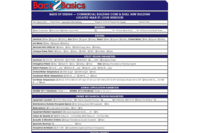Danfoss, a global manufacturer of high-efficiency electronic and mechanical components and controls for a/c, heating, refrigeration, and motion systems, hosted the event, which set out to explore today’s challenges and tomorrow’s path to an improved energy future. The symposium prompted discussions that affirmed the powerful future of energy efficiency technology, despite immediate and long-term obstacles.
Senator Jeff Bingaman (D-NM), chairman, Energy and Natural Resources Committee, delivered the keynote address. In addition to comments by Robert Wilkins, Danfoss vice president for government affairs, the day’s agenda included presentations from the following.
• Stephen R. Yurek, president and CEO, Air-Conditioning, Heating, and Refrigeration Institute (AHRI)
• David Kyle, vice chairman, Air Conditioning Contractors Association (ACCA)
• Greg Dobbs, director, distributed generation research & education, Penn State University
• Reid Detchon, vice president, energy and climate, United Nations Foundation; and executive director, Energy Future Coalition
• Lane Burt, director, technology policy, United States Green Building Council (USGBC)
• Karen Penafiel, vice president, advocacy, Building Owners and Manufacturers Association (BOMA) International
• Eugene Smithart, director, systems and solutions, Trane
Senator Bingaman opened the discussion with a four-part proposal for making the United States more competitive in clean energy technology, a field of growing importance as nations around the world work to cut greenhouse emissions and take the lead in a new marketplace. Senator Bingaman set the priorities on renewed commitment to clean energy R&D, strengthening the domestic market for clean energy technologies, expanding the financial infrastructure for investment incentives in clean energy products and equipment, and promoting U.S. manufacturing capabilities.
MISSION: FACING THE NEW CHALLENGE
Wilkins outlined the new challenge facing the HVAC and building industries on energy efficiency. He suggested a three-part approach: mapping the present situation; looking at longer-term research being launched and what it might make possible; and exploring ideas surfacing in the marketplace to drive energy efficiency technology. “Since 2008, we have witnessed an economic blitz, policy has stalled, the House of Representatives has changed hands, and the Senate may yet,” he said. “Progress will depend on exceptional leadership and creativity in industry.”
AHRI President Stephen Yurek focused attention on the evolution of efficiency standards. The United States made strides with energy efficiency standards since the 1970s, but needs to focus as well on a deeper problem, one that emerged in a previous 2010 EnVisioneering Symposium — the concept of “Max Tech.” The problem is simply that current equipment is approaching maximum levels of potential efficiency. Essentially, a natural cap exists, according to the laws of physics, on how much efficiency can be achieved with current HVACR product designs.
A whole-building systems approach, however, would open a new range of possibilities. Still, the whole building systems strategy means both a radical departure from most existing practices and a fresh look at the way we approach standards.
Yurek was uncompromising. “We need to apply the same leadership and ingenuity we have in the past to the broader building concepts that include the whole-building approach for our industry, the country, and the globe,” he said.
Air Conditioning Contractors Association Board of Directors Vice Chairman David Kyle underscored an equally challenging fact: not much of the energy-efficient equipment currently installed is functioning at optimum performance levels. A lack of enforcement has resulted in equipment installation and maintenance that is frequently below par. In effect, the building industry has been suffering from the belief that that buying equipment meant getting efficient performance. As Kyle put it, “It may not be enough to think outside the box. The box may be broken.”
The good news is that there is a deep well of performance improvements yet to be tapped. To gain these benefits will mean more enforcement — which will drive contractors to seek better tools, better education and training, and more stringent quality control and business development practices. The key is to support — which means reward — quality contractors if the goal is quality performance.
THE RESEARCH FRONTIER: CREATING THE ‘NEW BUILDING’
If Yurek and Kyle made clear that major efficiency improvements would require major shifts in strategy and practice, Greg Dobbs of Penn State University outlined an even more radical approach to the future of buildings. Dobbs described the Greater Philadelphia Innovation Cluster (GPIC) for Energy-Efficient Buildings as an experiment to bring to life the buildings of tomorrow. It is a vision rooted in whole building systems, highly professional building delivery and maintenance, and a new grid-building relationship.
GPIC is a joint project between Penn State and 22 other members funded by the U.S. Department of Energy, geared to making fully instrumented, reconfigurable, integrated whole building systems believable through real-life demonstrations at The Philadelphia Navy Yard in Philadelphia — a whole new approach to imagining what the future of buildings can be.
As one of five DOE centers at The Navy Yard, GPIC is a high visibility project. President Obama launched the initiative in February with a speech at the university’s main campus in State College, PA. Located in one of the country’s most prominent cities, The Navy Yard site is also custom made for the project with approximately 270 older buildings that can be renovated for a variety of uses, including residential, commercial, industrial, research, retail, and historical. The site is self-contained, and offers a fertile and diverse set of opportunities for innovation in existing buildings, which are a crucial element in an energy efficient future.
DRIVING CHANGE TODAY: NEW INDUSTRY STRATEGIES FOR HIGHER EFFICIENCY
In his presentation, Reid Detchon, who heads up the Energy Future Coalition and serves as vice president for energy and climate at the United Nations Foundation, outlined new opportunities for bringing low-cost financing to the table to support energy efficiency technologies that make economic sense. In addition, Detchon highlighted the advantages of continuous commissioning, whereby building owners contract with an off-site agency to monitor the building systems and complete routine check-ups, ensuring that buildings will perform as well in five years as they do on the first day.
BOMA International Vice President for Advocacy Karen Penafiel addressed the challenge of data acquisition on multi-tenant buildings and its link to broader building efficiency strategy issues. Under current regulations, tenants must give permission in order for buildings to collect aggregate data, but tenants frequently either decline to have the data aggregated or cannot be reached. The ability to get this important information could decisively strengthen the argument for a whole building approach.
Eugene Smithart, director for systems and solutions at Trane, closed the program with the suggestion that the longstanding challenge of “first cost” could be overcome with existing technology and a major dose of ingenuity.
As an example, Smithart outlined an ICE approach to energy efficiency and energy savings, a system that uses a chiller to create ice overnight, or when chiller load is lightest, to be used with the chiller to cool the building throughout the day, reducing first costs, life-cycle costs and energy costs.
Danfoss North America President John Galyen brought the meeting to a close, observing, “If we as an industry can figure out a way to tie together first cost orientation, delivering on the promise of life-cycle costs through better education and accountability, and keeping that promise over the long run and for many years, we can achieve great strides — certainly, we will be a lot further along than we are today.”
Danfoss launched the first EnVisioneering Symposium in 2006 to keep stakeholders abreast of developments in policy and industry and present a forum for ongoing dialogue among industry thought leaders in research and development and the policy community.




